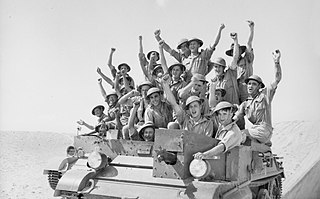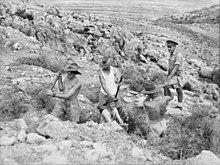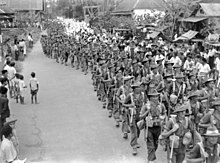
The 7th Division was an infantry division of the Australian Army. It was formed in February 1940 to serve in World War II, as part of the Second Australian Imperial Force. The division was raised on the British establishment of nine infantry battalions per division and consisted of two new brigades and three of the original 12 battalions of the 6th Division forming the third brigade. The division is sometimes known by the nickname "The Silent Seventh", due to a perception that its achievements were unrecognised, in comparison to the other Australian divisions. The origin of this belief appears to be censorship of the part played by the 7th Division in the fierce fighting in the 1941 Syria-Lebanon campaign. The 7th Division along with the 6th and 9th Australian Divisions were the only divisions to serve in both the Middle East and the South West Pacific Area. It was disbanded in 1946, following the end of the war.

The 2/1st Battalion was an infantry battalion of the Australian Army. Formed as part of the Second Australian Imperial Force at the start of World War II, the battalion was deployed to the Middle East in early 1940 and subsequently took part in the early fighting in the North African campaign, taking part in battles around Bardia and Tobruk before later being sent to Greece in early 1941. A lightning German advance quickly pushed the Allies back and forced them to evacuate after a very short campaign and the 2/1st was landed on Crete where they subsequently fought unsuccessfully to repel a German invasion in May. The majority of the battalion was captured on Crete, but the 2/1st was subsequently re-built from survivors in Palestine and returned to Australia in early 1942 following Japan's entry into the war. They then fought two campaigns against the Japanese in New Guinea, fighting in the Kokoda Track campaign during 1942–43 and the Aitape–Wewak campaign in 1944–45. Following the war, the 2/1st was disbanded.

The 2/2nd Battalion was an infantry battalion of the Australian Army raised for service as part of the all-volunteer Second Australian Imperial Force during World War II. Raised in October 1939, the battalion was deployed to the Middle East and in early 1941 took part in the first ground action undertaken by Australian troops during the war during the Battle of Bardia before helping to capture Tobruk. In April, the battalion briefly fought in Greece, before being evacuated after the Allied forces were overwhelmed by German forces. Some members of the battalion took part in the Battle of Crete, after which the battalion undertook garrison duties in Syria. In mid-1942, the 2/2nd undertook defensive duties in Ceylon before returning to Australia. They subsequently took part in the fighting against the Japanese along the Kokoda Track and then around Buna–Gona. After a period of reorganisation and training in Australia throughout 1943–44, late in the war the battalion was committed to the Aitape–Wewak campaign before being disbanded in early 1946 after the war.

The 2/3rd Battalion was an infantry battalion of the Australian Army. Raised for service during the Second World War as part of the Second Australian Imperial Force, it was formed in October 1939 in Sydney and was attached to the 16th Brigade, 6th Division, the first formation raised as part of the 2nd AIF during the war. Deploying to the Middle East in early 1940, it saw action in North Africa, Greece, Crete, and Syria in 1941–1942 before returning to Australia following Japan's entry into the war, and was one of only two Australian infantry battalions to fight against all the major Axis powers of the war: the Germans, Italians, Japanese and Vichy French.

The 2/4th Battalion was an infantry battalion of the Australian Army that was raised for service during World War II, as part of the Second Australian Imperial Force. Deploying to the Middle East in early 1940, the battalion took part in the early fighting in North Africa in early 1941 along with the rest of the 6th Division, before being sent to Greece and then Crete, where it was heavily engaged and suffered heavy losses. Rebuilt in Palestine, the battalion undertook occupation duties in Syria.

The 2/7th Battalion was an infantry battalion of the Australian Army raised for service during World War II. Formed as part of the 6th Division shortly after the outbreak of the war as part of the all-volunteer Second Australian Imperial Force, the 2/7th Battalion's initial personnel were recruited primarily from the state of Victoria, although later reinforcements were drawn from most other Australian states. Basic training was completed in Australia, after which the battalion embarked for the Middle East as part of the first batch of Australian troops to deploy overseas. Further training was undertaken in Palestine before the battalion went into action against the Italians in January 1941. After participating in the successful capture of Bardia and Tobruk, it was committed to the disastrous Battles of Greece and Crete, where the battalion was essentially destroyed after the majority of its personnel were captured.

The 2/10th Battalion was an infantry battalion of the Australian Army that was raised for overseas service as part of the all-volunteer Second Australian Imperial Force during World War II. Formed in October 1939, it was the first 2nd AIF unit raised from the state of South Australia during the war; after completing a period of training in Australia, the battalion embarked for overseas service. Initially, it had been intended that the 2/10th and its parent brigade – the 18th Brigade – would be sent to the Middle East to join the other brigades of the 6th Division, but instead the 18th Brigade was sent to strengthen the garrison in the United Kingdom after France capitulated in mid-1940. Re-assigned to the 9th Division, the 2/10th remained in the United Kingdom undertaking defensive duties until late 1940 when it finally arrived in the Middle East, where the 18th Brigade became part of the 7th Division.

The 18th Brigade was an infantry brigade of the Australian Army. The brigade briefly existed as a Militia formation prior to the First World War, but this was short-lived. During the Second World War, the brigade was raised on 13 October 1939 and was one of the first three infantry brigades of the Second Australian Imperial Force to be formed. Initially commanded by Brigadier Leslie Morshead, it served in the United Kingdom in 1940–1941, where it helped bolster the British garrison in anticipation of a possible German invasion following the Fall of France. In early 1941, the brigade was transferred to the Middle East where it later took part in fighting against the Italians in Libya and then helped to defend the besieged port of Tobruk before fighting against the Vichy French in the Syria–Lebanon campaign. The 18th Brigade was withdrawn to Australia in early 1942, and it later took part in the fighting against the Japanese in Pacific fighting several campaigns in New Guinea between late 1942 and early 1944. Its final involvement of the war came in mid-1945 when it took part in re-taking Balikpapan. Following the end of hostilities, the 18th Brigade was disbanded on 3 January 1946.

The 2/16th Battalion was an infantry battalion of the Australian Army, serving during World War II. Attached to the 21st Brigade that was assigned to the 7th Division, the 2/16th was raised in 1940 as part of the Second Australian Imperial Force from volunteers drawn mainly from the state of Western Australia. After training in Australia, the battalion was deployed to the Middle East where it undertook defensive duties along the Egyptian–Libyan border in early 1941 before taking part in the Syria–Lebanon campaign, fighting against Vichy French forces in June and July. At the conclusion of the campaign, the 2/16th remained in Lebanon, contributing to the Allied occupation force there, before returning to Australia in early 1942 following Japan's entry into the war. In August 1942, they were committed to the fighting along the Kokoda Track and then later fought around Buna and Gona. After a period of rest and reorganisation in Australia, the battalion fought around Lae and then took part in the Finisterre Range campaign in 1943–44. Its final campaign of the war came in Borneo in July 1945. At the end of the war, the 2/16th were disbanded in January 1946.

The 31st/51st Battalion was an infantry battalion of the Australian Army, which served during World War II. Raised for service as part of the Militia in 1943 through the amalgamation of two previously existing battalions, the 31st/51st Battalion undertook garrison duties in Dutch New Guinea in 1943–44 before taking part in the Bougainville Campaign in 1944–45. Following the end of the war, the battalion served in the Pacific overseeing the transfer of Japanese prisoners of war and re-establishing law and order until mid-1946 when it returned to Australia and was disbanded.

The 2/9th Battalion was an infantry battalion of the Australian Army during World War II. Raised in Queensland as part of the Second Australian Imperial Force shortly after the outbreak of the war, it formed part of the 18th Brigade and over the course of the war it was attached to the 6th, 9th and 7th Divisions due to several re-organisations. It served in the United Kingdom in 1940, forming part of a small Australian garrison sent there to help defend against a possible German invasion, before being transferred to North Africa where it took part in the Siege of Tobruk and then undertook garrison duties in Syria following the Syria–Lebanon campaign in 1941.

The 25th Brigade was a brigade-sized infantry unit of the Australian Army that served during the Second World War. Raised in July 1940 and consisting of three infantry battalions, the 25th Brigade initially served in the United Kingdom, where it formed part of the garrison tasked with defending against a possible German invasion. In 1941, the brigade was redeployed to the Middle East where it took part in the Syria–Lebanon campaign fighting several actions around Merdjayoun and Jezzine.

The 2/12th Battalion was an infantry battalion of the Australian Army which served during World War II. Raised in late 1939 as part of the all volunteer Second Australian Imperial Force, the battalion's initial recruits were drawn primarily from the states of Queensland and Tasmania. Assigned to the 18th Brigade, the battalion completed basic training in Australia before embarking for overseas in May 1940.

The 21st Brigade was a brigade-sized infantry unit of the Australian Army. It was briefly raised in 1912 as a Militia formation providing training as part of the compulsory training scheme. Later, it was re-formed in April 1940 as part of the Second Australian Imperial Force, the unit was raised for service during World War II. As part of the 7th Division the brigade's constituent units were raised from volunteers from several Australian states. After rudimentary training in Australia, the brigade deployed for the Middle East in October 1940. Defensive duties were mounted along the Libyan border in early 1941, before the brigade was committed to the Syria-Lebanon campaign, fighting against Vichy French forces. In early 1942, following Japan's entry into the war, the brigade returned to Australia. After a period of defensive duties in Australia, it was deployed to New Guinea and subsequently played a key role in the Kokoda Track campaign, delaying the Japanese advance towards Port Moresby and then joining the pursuit as the Japanese withdrew towards Buna–Gona. In 1943–1944, the brigade took part in the capture of Lae and the Ramu Valley–Finisterre Range campaign. Its final campaign of the war, came in the final months when it took part in the Balikpapan landings. It was disbanded in 1946.

The 2/5th Field Regiment was an Australian Army artillery regiment formed in May 1940 as part of the Second Australian Imperial Force for service during World War II. Assigned to the 7th Division, the regiment undertook defensive duties in Egypt during the North African campaign in early 1941, before taking part in the Syria–Lebanon campaign. Occupation duties followed before the regiment was brought back to Australia in early 1942, in response to Japan's entry into the war. The regiment subsequently fought two significant battles in New Guinea in 1942–1943 at Milne Bay and Buna before undertaking garrison duties around Port Moresby until early 1944. Withdrawn to Australia, the regiment's final campaign came late in the war when it was committed to the Borneo campaign, taking part landing at Balikpapan. The regiment was disbanded in early 1946.

The 2/14th Battalion was an infantry battalion of the Australian Army that served during World War II. Part of the 21st Brigade, 7th Division, the battalion was raised from Second Australian Imperial Force volunteers drawn mainly from the state of Victoria. After completing training in Australia in 1940, the battalion deployed to the Middle East where it was stationed in Egypt and Palestine before it saw action against the Vichy French in Syria in June and July 1941, in a short lived campaign. Garrison duties in Lebanon followed before the battalion was withdrawn to Australia in early 1942 as Australian forces were concentrated in the Pacific to respond to the threat posed by Japan's entry into the war.

The 2/33rd Battalion was an infantry battalion of the Australian Army during the Second World War. It was formed as part of the Second Australian Imperial Force in the United Kingdom in June 1940 as the "72nd Battalion" to create the 25th Brigade, which eventually became part of the 7th Division. After the threat of invasion had passed, the battalion was transferred to the Middle East in early 1941, and after a period of garrison duty in the Western Desert, the battalion fought against the Vichy French in the invasion of Syria and Lebanon.

The 2/27th Battalion was an infantry battalion of the Australian Army during World War II. Raised in May 1940 as part of the 7th Division from volunteers from the state of South Australia, the battalion was assigned to the 21st Brigade. After completing training in Australia, the 2/27th deployed to the Middle East in November 1940, and in early 1941 undertook defensive duties in the Western Desert. The battalion's first combat experience came against the Vichy French during the short Syria–Lebanon campaign during which it fought major engagements around Sidon and Damour. At the conclusion of the fighting in Syria, the battalion remained in the area as part of the Allied occupation force until early 1942 when it was returned to Australia to fight against the Japanese.

The 2/1st Pioneer Battalion was a pioneer battalion of the Australian Army during World War II. Raised in early 1940, the battalion served throughout the war, seeing action in North Africa, particularly around Tobruk in 1941, before being brought back to Australia in 1942. It later took part in the fighting against the Japanese in New Guinea in 1942–43, and then in Borneo in 1945. It was disbanded in early 1946. The battalion undertook both infantry and engineer tasks.

The 2/28th Battalion was an infantry battalion of the Australian Army, which served during the Second World War. Formed in mid-1940 from Western Australian volunteers, the battalion served in North Africa in 1941–42 as part of the 24th Brigade, which was assigned to the 9th Division. The battalion's first major engagement came during the Siege of Tobruk, where the battalion carried out defensive duties as part of the garrison for over six months before being withdrawn by sea. After undertaking occupation duties in Syria and Lebanon, the 2/28th took part in the First Battle of El Alamein in mid-1942 during which it was heavily depleted, and had to be rebuilt prior to its commitment to the Second Battle of El Alamein later in the year. In early 1943, the battalion returned to Australia and later took part in campaigns against the Japanese in New Guinea in 1943–44, where it was committed to capturing Lae, and then clearing the Huon Peninsula, and then retaking Borneo in 1945. After the war, the battalion was disbanded in early 1946.





















